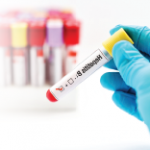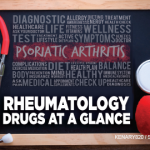Rituximab has recently received a boxed warning due to the associated risk of immunosuppressive-related hepatitis B virus (HBV) reactivation.8 Additional recommendations for screening, monitoring, and managing patients treated with rituximab and another immunosuppressive agent, ofatumumab, are also included in the revised label to decrease patient risk. After taking either of these two these immunosuppressive agents, some patients with prior HBV infection have developed fulminant hepatitis, hepatic failure, and have even died. To decrease the risk of HBV reactivation, the FDA recommends the following: 1) all patients to be treated with these agents be screened for HBV infection by measuring hepatitis B surface antigen (HBsAg) and hepatitis B core antibody (anti-HBc) prior to therapy commencement; 2) when screening identifies patients at risk for HBV reactivation due to prior HBV infection, consult with hepatitis experts concerning use of antiviral (HBV) therapy and patient monitoring; 3) monitor high-risk patients taking rituximab for laboratory signs of HBV reactivation (e.g., elevated alanine aminotransferase and/or aspartate aminotransferase levels, elevated alkaline phosphatase levels, gamma-glutamyl transpeptidase levels, bilirubin levels, albumin levels, etc.) and clinical signs of HBV reactivation (e.g., nausea, intermittent mild-to-moderate right upper quadrant and epigastric pain, disordered gustatory and smell sensations, anorexia, myalgia, low-grade fever, fatigue, etc.). This should be done within the first several months of treatment.9 Reactivation has occurred several months after starting these immunosuppressive agents. If patients develop HBV reactivation, the immunosuppressive agent should be immediately discontinued, and HBV therapy should be started. At present, no recommendation can be made about resuming treatment with immunosuppressive agents.
Michele Kaufman is a freelance medical writer based in New York City, a pharmacist at New York Presbyterian–Lower Manhattan Hospital, and adjunct faculty at Touro College of Pharmacy.
References
- FDA Clears new dosage for buprenorphine pain patch. Published September 24, 2013. www.medscape.com/viewarticle/811557. Accessed September 25, 2013.
- Novartis receives EU approval for Ilaris in active systemic juvenile idiopathic arthritis, a serious form of childhood arthritis. Published September 4, 2013. www.medicalnewstoday.com/releases/265629.php. Accessed September 11, 2013.
- McInnes IB, Kavanaugh A, Gottlieb AB, et al. Efficacy and safety of ustekinumab in patients with active psoriatic arthritis: 1 year results of the phase 3, multicentre, double-blind, placebo-controlled PSUMMIT 1 trial. Lancet. 2013;382:780-789.
- Walsh K. FDA OKs Stelara for Psoriatic Arthritis. Published September 24, 2013. www.medpagetoday.com/Rheumatology/Arthritis/41808. Accessed September 24, 2013.
- Barber J. Johnson & Johnson’s Stelara approved in US, Europe for psoriatic arthritis Published September 23, 2013. www.firstwordpharma.com/node/1141095#axzz2frcean47. Accessed September 24, 2013.
- Fentanyl patch can be deadly to children. Published September 24, 2013. www.fda.gov/forconsumers/consumerupdates/ucm300803.htm. Accessed September 24, 2013.
- Liscinsky M. FDA announces safety labeling changes and postmarket study requirements for extended-release and long-acting opioid analgesics. Published September 10, 2013. www.fda.gov/NewsEvents/Newsroom/PressAnnouncements/ucm367726.htm. Accessed September 24, 2013.
- Arzerra (ofatumumab) and Rituxan (rituximab): Drug Safety Communication—New boxed warning, recommendations to decrease risk of hepatitis b reactivation. Published September 25, 2013. www.fda.gov/Safety/MedWatch/SafetyInformation/SafetyAlertsforHumanMedicalProducts/ucm369846.htm. Accessed September 27, 2013.
- Pyrsopoulos NT, Reddy KR, Katz J, et al. Hepatitis B. Medscape Published June 19, 2013. http://emedicine.medscape.com/article/177632-overview. Accessed September 29, 2013.


